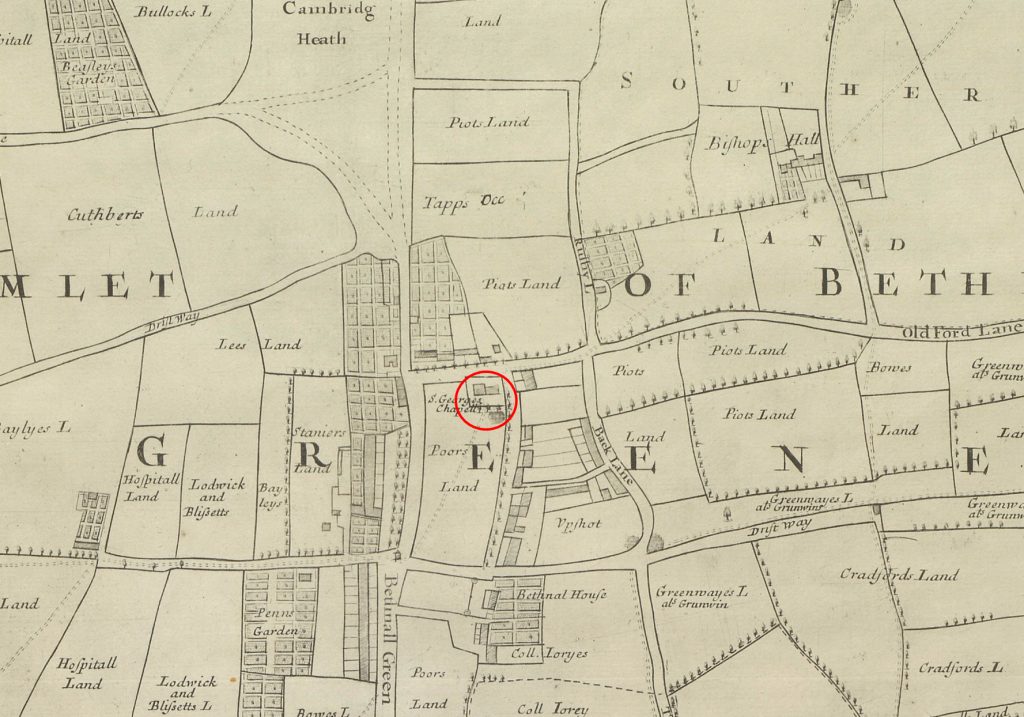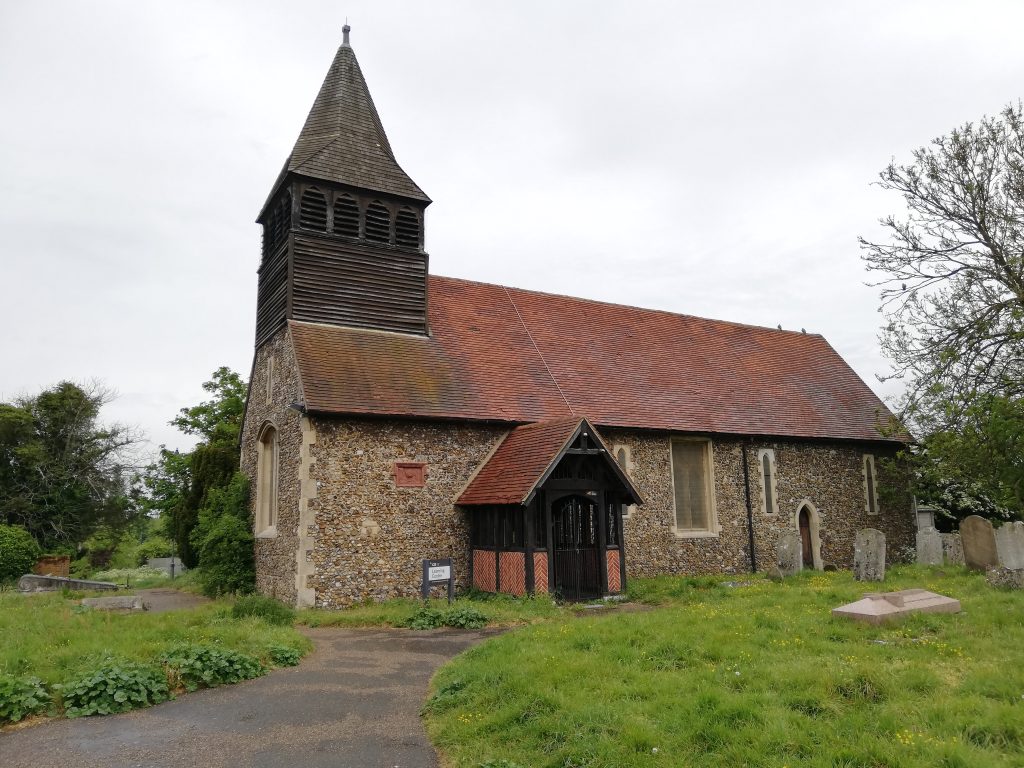The houses on The Terrace, Old Ford Road occupy the site of St. George’s Chapel (now Nos. 1-4 The Terrace) and the adjacent cottage (now Netteswell House, 5 The Terrace). The chapel of ease is known to have been in existence by 1512 (when it received £1 as a New Year gift from King Henry VIII).
In 1547, the cottage and chapel were leased by Bishop Bonner (who held the manor of Stepney) to Sir Ralph Warren (c. 1486–1553), who was Lord Mayor of London twice, in 1536 and in 1543.
A clue to the early history of Netteswell House was furnished by Richard Newcourt’s diocesan history of London, Repertorium Ecclesiasticum, published in 1708. According to Newcourt, “this Chapel and a Messuage built under one Roof, with a garden,” were leased for ninety-nine years by Edmund Bonner, Bishop of London, to Sir Ralph Warren and his wife in 1547, “they paying the said Bishop and his successors IVd. a year”. Even allowing for immense differences in the value of money four centuries ago, fourpence a year suggests that Warren rented a property which was in ruins and built himself a new house on the site. A tablet on the front of Netteswell House states that it was erected in 1553 and restored in 1705 and in 1862.
C.M. Weekley, Netteswell House and Bethnal Green, Transactions of the London and Middlesex Archaeological Society, vol. 19, p.113 (1958)

Warren had two children by his second wife Joan Trelake. Their daughter, Joan Warren, married her father’s ward, Sir Henry Williams, alias Cromwell, of Hinchinbrooke in Huntingdonshire, whose son Robert Cromwell was the father of Oliver Cromwell, Lord Protector of England, Scots and Ireland.
Warren died in 1553, the year stated on the plaque above the main (south) door.
This Tuesday, beinge the 11 of July, at v of the clocke at night, Sir Raphe Warreine, knight, alderman, departed out of this lyfe at Bednalne Grene at his house, which sayd Warreine had borne the office of the mayraulty two tymes in the City of London, and was the auntient alderman of the Bench, and euer a trewe and good citizene and a specyall benefactor to the same, and that night, about x of the clocke, his bodye was brought in a horse litter to his house in London, and when he was rypped there were three great stones in his bladder, and another little one in one of his kidneis.
Charles Wriothesley, A Chronicle of England During the Reigns of the Tudors, From A.D. 1485 to 1559 (‘Wriothesley’s Chronicle’), ii, 87
It is difficult to trace the ownership of Netteswell House following Warren’s death in 1553. A History of the County of Middlesex: Volume 11, Stepney, Bethnal Green, ed. T F T Baker (1998), states:
In 1538 the royal favourite Anthony Denny (d. 1549) of the Privy Chamber held a house and lands which he conveyed in 1544 to Sir Ralph Warren (d. 1553), lord mayor of London, who acquired Burgoyns and was leased St. George’s chapel for 99 years from 1547. Successive holders were Sir Ralph’s widow, his son Sir Richard (d. 1597) from 1572, and his grandsons, sons of his daughter Joan (d. 1586), wife of Sir Henry Cromwell. In 1601 they sold the estate, first described in full, to Richard Pyott (d. 1620), a London grocer and alderman.
A History of the County of Middlesex: Volume 11, Stepney, Bethnal Green, ed. T F T Baker ( London, 1998), British History Online
Presumably the Pyott family held the lease of St. George’s Chapel until it expired in 1646. According to Pevsner:
… its present appearance, of two storey’s and attics in Flemish bond, must be c. 1646, when Warren’s lease expired. Of that date at least the two curved gables with their pediments are characteristic (cf. The Dutch House, Kew, 1631).
Bridget Cherry, Charles O`Brien and Nikolaus Pevsner, The Buildings of England, London 5: East (2005)
At this time, the manor of Stepney was held by Thomas, Lord Wentworth, earl of Cleveland. The estates of Cleveland, who fought for Charles I during the English Civil War, were sequestered in 1650. Cleveland recovered the manor after the Restoration – but the confiscation of his assets gave rise to the July 1651 ‘Act for the sale of several Lands and Estates forfeited to the Commonwealth for Treason’.
A ‘transliteration’ of the survey of the manor of Stepney that followed this Act made by Bethnal Green librarians in 1932 reads:
There is now standing upon Bethnal Green aforesaid between the great pond on the Waste there and the Highway leading from Bethnal Green to Old Ford aforesaid an old Chapel with a cottage at the west end thereof, heretofore by Edmond (Bonner) bishop of London aforesaid by his indenture of lease bearing date the 1st day of July in the first year of King Edward VI [1547] demised unto Ralph Warren for the term of 99 years, under the yearly rent of four pence, and since the expiration of the said term [1 July 1646], in part repaired by the Inhabitants of the said Hamlet (Bethnal Green), and now used for a Preaching place where there are three services weekly, viz 2 services on the Lord’s day and one only [on] Tuesday:
Which said Chapel and Cottage, together with a parcel of the Waste about it, containing about 40 yards in length and 20 yards in breadth, lately set and staked out by divers Copyholders of the said Manor by virtue of a precept from the Steward of the said manor unto them directed for that purpose, according to the Custom of the Manor, (Which properties), were they not employed to a pious use, we should value to be worth per annum 30/-
But the Inhabitants of the said Hamlet do humbly pray that the same may be conveyed and settled so to certain persons, which they will name, and their heirs in trust for the said Hamlet, to be forever continued and employed to the said pious use beforementioned. As they do also a certain Watch-house (being only one Room about 10 foot square) lately built at the charges upon the Waste there for shelter of Watchmen in the night. Which desires of theirs we humbly recommend.
In 1667, control of Cleveland’s estates passed to Philadelphia, wife of his son Thomas, Lord Wentworth, who sold the manor in 1695 to William Herbert, known as Lord Montgomery. The manor of Stepney passed to Windsor Sandys in 1710; and to John Wicker the younger in 1720.
With the estate being sold off by Philadelphia, Thomas Rider and other owners of houses around the Green purchased the land in 1678 in order to stop developers building on it. A trust was set up, whereby the land (known as ‘Poor’s Land’) would not be built on, and the income from it was to be given to the local poor.
It is not known who the occupants of the chapel house were during this time, but it was restored in 1705.
A History of the County of Middlesex states that Anthony Natt (d. 1756), a carpenter, “bought what was described as the chapel house in 1748 and shortly afterwards built two houses adjoining it to the west. In 1772 his son Anthony Natt, rector of Netteswell (Essex), bought the freehold from the lord of the manor and in 1790 employed Ruby, a carpenter, to replace the two houses with four, forming the Terrace, Old Ford Road.”

It seems more likely that the chapel had already been replaced by two houses by 1744, i.e. before Natt acquired the buildings. According to M.F. Elliston in A Topography of Tower Hamlets (unpublished), St. George’s Chapel was demolished in 1720 to be replaced by two houses. This date is consistent with the following extract from The Green: A history of the heart of Bethnal Green and the legend of the Blind Beggar by AJ Robinson and DHB Chesshyre:
Judging from the ratebooks from 1744 onwards the chapel and its adjoining residence had turned into three houses. Sometime towards the end of the 18th century the freehold of the terrace including Netteswell House was purchased by the Rev. Anthony Natt, and he himself is listed here in the Land Tax Assessment of 1777. His father had already taken a 20 year lease on it in 1748. In his will of 1801 he mentions two freehold estates in Bethnal Green: the first being the three houses built by his father (17-21 Old Ford Road), and the second being The Terrace and Netteswell House. He describes the latter as “five other messuages with the gardens…etc. which I purchased of Sir George Colebrook Baronet” (Lord of the Manor of Stepney) “four of which … messuages have lately been built by me upon the site of the ground whereon two messuages lately stood”.
AJ Robinson and DHB Chesshyre, The Green: A history of the heart of Bethnal Green and the legend of the Blind Beggar, London Borough of Tower Hamlets Central Library (1978)